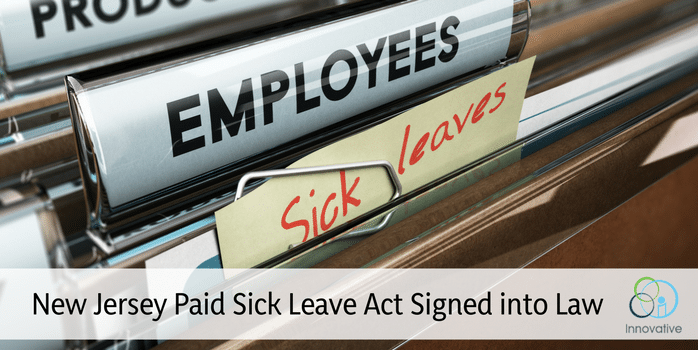New Jersey has now become the tenth state to enact a statewide mandatory paid-sick-leave law. The New Jersey Paid Sick Leave Act was signed into law on May 2nd by Gov. Phil Murphy and will go into effect on Oct. 29, 2018. Once effective, it will require New Jersey employers of all sizes to provide up to 40 hours of paid sick leave per year to covered employees.
Just about every employer with workers in New Jersey will feel the impact of this new law. Consequently, you should start preparing now to ensure your policies and practices are compliant with the Act.
Who Is Covered?
Covered employees: The act applies to most employees working in the state “for compensation.” The act expressly excludes employees in the construction industry employed under a collective bargaining agreement, per diem healthcare employees, and public employees who already have sick leave benefits.
Covered employers: The act broadly applies to any business entity, regardless of size, that employs employees in the state of New Jersey. It expressly excludes public employers required to provide their employees with sick leave.
How Is Leave Accrued?
Accrual period: The act requires employers to designate any period of 12 consecutive months as a “benefit year.” Employers cannot change the established benefit year without first notifying the New Jersey Department of Labor and Workforce Development. Under the act, current employees begin accruing sick time on the effective date of the act (October 29th, 2018). New employees hired after the effective date of the act begin accruing sick time on the first date of their employment.
Accrual limits: In each benefit year, an employee will accrue up to 40 hours of sick time at a rate of one hour for every 30 hours worked. An employer may “frontload” the full 40 hours at the beginning of the benefit year. Employers with existing paid time off (PTO), personal days, vacation days and sick-day policies may utilize those policies to satisfy the requirements of the act as long as employees can use the time off as required by the act.
How Can Leave Be Used?
Employers are not required to permit employees to use more than 40 hours of sick leave in a benefit year. Employees can use accrued sick time after the 120th day of their first date of employment for the following reasons:
- Diagnosis, care or treatment of—or recovery from—an employee’s own mental or physical illness, including preventive medical care.
- Aid or care for a covered family member during diagnosis, care or treatment of—or recovery from—the family member’s mental or physical illness, including preventive medical care.
- Circumstances related to an employee’s or their family member’s status as a victim of domestic or sexual violence (including the need to obtain related medical treatment, seek counseling, relocate or participate in related legal services).
- Closure of an employee’s workplace or of a school/childcare of an employee’s child because of a public official’s order relating to a public health emergency.
- Time to attend a meeting requested or required by school staff to discuss a child’s health condition or disability.
What Rules Govern Carryover and Payout?
Maximum carryover: The act does not require employers to permit employees to carry over more than 40 hours of accrued sick time in a single benefit year.
Optional buyout: Employers may, but are not obligated to, offer to pay employees for their unused accrued sick time in the final month of the benefit year. If employees agree to receive the payment, they may choose a payment for the full amount of their unused accrued sick time or for 50 percent of such time.
The payment amount shall be based on the same rate of pay that the employee earns at the time of the payment. If an employer frontloads the entire amount of sick time, it must either pay the employee for the full amount of unused accrued sick time in the final month of the employer’s benefit year or carry forward any unused sick time to the next benefit year.
What Happens Upon Transfer, Separation or Reinstatement?
If an employee is employed by a successor employer or transferred to a separate division, entity or location of the same employer, the employee will retain and be entitled to use all accrued sick time.
Separation of employment: Unless the employer has a policy or collective bargaining agreement providing for the payment of accrued sick leave upon termination, resignation, retirement or other separation from employment, the act does not require the employer to pay employees for unused accrued sick leave upon the separation from employment.
What Notice and Documentation Is Required?
Foreseeable absences: Employers may require advance notice, not to exceed seven calendar days, of the intention to use the leave and the expected duration. Employers may require employees to make a reasonable effort to schedule the use of sick leave in a manner that does not unduly disrupt the operations of the employer.
Unforeseeable absences: Employers may require employees to give notice of the intention to use the leave as soon as practicable.
Absences of three days or more: If an employee is absent for at least three consecutive days, the employer may require documentation that confirms that the employee used sick leave for a covered purpose.
Notice and Record-Keeping Rules
Employers must post a notification of employees’ rights under the act and provide employees with a written copy of the notice within 30 days after NJ has issued a model notice. Additionally, employers must retain records for a period of five years.
What Should Employers Do Now?
In anticipation of the effective date of this new law, you should review your paid time off policies to determine whether you will have to implement a paid-sick-time policy for any of your employees or amend your existing policies to ensure compliance with the act. If you have questions about how this law impacts your organization, please don’t hesitate to contact us at (888) 427-7383.












